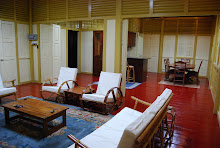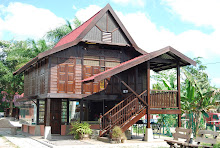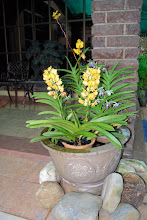
This panoramic view of the south-eastern corner of George Town gives an idea of the existing tile roofs that cover a section of the city. The assembly at the left hand- corner of the picture are students of St.Xavier's Institution. The school as we see has an extensive tile roofing too. Viewed from Bay View Hotel.

Another view but with lesser concentration of tiles roofing due to the nature of the buildings.Seen across the channel is Butterworth town.
Chinese or V tiles on the battens for the participants to view. An exercise at arranging them for steadiness, correct placement and no leakages were carried out. Participants learned the correct methodology
 Singgora Tiles, each piece costlier than the Chinese or V tiles. Buildings on the East Coast: Kelantan and Trengganu used this tiles and the name indicates its origin from Thailand. 'Marseilles' is another brand tile in the market.
Singgora Tiles, each piece costlier than the Chinese or V tiles. Buildings on the East Coast: Kelantan and Trengganu used this tiles and the name indicates its origin from Thailand. 'Marseilles' is another brand tile in the market. It's a long due visit to the island though only an hour drive from Alor Star if you could weave through the traffic on the Penang Bridge. This weekend happened to be our chance to see the island since its recognition by UNESCO as a heritage city in partnership with Malacca. Still it was no 'makan angin' right through since we came to attend the third series of the Jabatan Warisan Negara's conservation workshop. At least my wife did - fully.

Chinese type tiles on these buildings look intact and neat.

This Chinese temple built in 1895 has been restored and renovated. It is marked on the tourist heritage trail map. Pulau Pinang being a busy port in olden days, therefore the seafarers built this temple in respect of their patron saint. The distinguishing tiles marked the characteristic of the building which must have required skilled craftsmen.
As the subject matter goes, it is more concerned with 'TILES' and how refreshing to know the varied types that encapsulate our roofs and give comfort and protection all these years. If there is a roofing fraternity, then definitely PULAU PINANG can be called to become its chief proponent for continuance of tiles roofs all over the city. While many other cities have transformed their bird's eye view, the island existed without much change. An aerial view discloses brown tile roofs all over the city center. The excitement grows when the workshop participants go down to discover various types of tile roofing, including mode of cleaning and the practical laying them on the battens. A site visit to a building under conservation works, give a complete picture of things and other expectancies when working with heritage buildings. Here participants got on to their knees and hands again to realize the rudiments and necessities of engaging in heritage buildings and conservation works.

The practical experience was carried out at this 'Strait's Eclectic' or 'Anglo-Malay' mansion situated at Lorong Hitin. Built in the early 1920's it typifies houses as that of Syed AlAtas at Jalan Armanian and Syed Sheikh Al Hadi's at Jalan Jelutong.

Another heritage building is the E & O Hotel. Recently refurbished and renovated it continues to give an air of resplendent and old world charm. Notice the extensive tile roofing

Before it was a typical Chinese Hotel in George Town ,now it has taken a new image. The roofs too have acquired fresh tilings.
Earlier at Taiping and Ipoh, the department had focused on timber and lime respectively being two proponents of the building industry especially involving restoration works. This latest workshop, tops it all, since almost all historical and heritage buildings would require tiles as replacements. Still the varieties of them need to be explored and explained. This is what the participants come to discover. I sat in for several of the papers to understand the basics. Still it was a good excuse to leave the classroom and roam around centuries old Pulau Pinang streets to shoot pictures of buildings with semblance of tiles' usages. Pictures would help to show the definite needs for conservationists (architects, designers, builders, relevant agencies, related consultants etc) to realize future potentials, while citizens become aware of their heritage and its value. Penang richness in heritage buildings has endured itself to visitors and during the weekend it gave that secret away. Hordes of foreign and domestic tourists have found their way to the island. The three-wheeled trishaws though a dying mode of transport continue to meander the streets carrying happy and curious faces as they take a leisure tour of old Penang.
 Pulau Pinang seems to have a treasure trove of such shop houses, of varied style and design. It is no surprise that the owners have started to restore them to their glorious days and in fact with more significance alongside their current usage. Bed and Breakfast or Travellers Lodge at such exotic buildings seems to attract foreign tourists to enjoy homely atmosphere.
Pulau Pinang seems to have a treasure trove of such shop houses, of varied style and design. It is no surprise that the owners have started to restore them to their glorious days and in fact with more significance alongside their current usage. Bed and Breakfast or Travellers Lodge at such exotic buildings seems to attract foreign tourists to enjoy homely atmosphere.
 The Chartered Bank of Penang Island. Being a Sunday morning, therefore the quietness and unhurried atmosphere.
The Chartered Bank of Penang Island. Being a Sunday morning, therefore the quietness and unhurried atmosphere.
 You would have pushed your money into this night safe had you been in Penang in the 1950's when the Chartered Bank utilised this safe for convenience of its clients. You can do the same now but at a better safe box.
You would have pushed your money into this night safe had you been in Penang in the 1950's when the Chartered Bank utilised this safe for convenience of its clients. You can do the same now but at a better safe box.
It was an enriching experience for me too as I discover treasures and richness of our heritage. For what there are in our own towns and villages we must try to salvage and help to preserve less they fade away. Jabatan Warisan Negara being a department under Kementerian Penerangan, Komunikasi dan Kebudayaan Malaysia is doing a yeoman service in this direction.
 Penang Town Hall
Penang Town Hall A business house situated at Beach Street. When nearby you would likely make your way to the "Whiteaways' an exclusive department store pre Merdeka time.
A business house situated at Beach Street. When nearby you would likely make your way to the "Whiteaways' an exclusive department store pre Merdeka time.

Swettenham Pier where large ships used to dock here. Recently upgraded it awaits luxury passenger ships to call here and making the island once again a touristic hub.
As a consultant firm, we look forward to an appointment by Badan Warisan for works on heritage building, working together towards preserving the old treasures for continuity.
A golden opportunity like this comes once in a blue moon. When can you get the chance to knock two big birds with a tiny stone? We did it in Penang from 14 to 16 August 2009. I abandoned the motorcar for a good walking exercise while clicking the shutters at random for a good collection of Pulau Pinang images.


Every where you go around the former business enclave you will find old buildings restored and and in spanking conditions. Won't be for long, before they are occupied again.

The Immigration Department Building at the corner of Beach Street .

Masjid Kampong Melayu recently restored by Jabatan Warisan Negara is also situated in the business zone of 'Tanjung'
 Masjid Kapitan Kling has also been restored to its original identity while establishing the extensive business zone of the Indian Muslims of 'Tanjung'.
Masjid Kapitan Kling has also been restored to its original identity while establishing the extensive business zone of the Indian Muslims of 'Tanjung'.

Adjacent to Masjid Kampong Melayu you will find this row of restored 'wakaf' houses.
An old map of George Town dated 1798 shows clearly the topography and morphology of the settlement around the cape i.e 'tanjung'. In complete evidence till now the trading houses located at Chulia Street ( Malabar Street), Pitt Street ( Masjid Kapt Kling Street), Light Street and Beach Street proved its truth. Being close to the harbor and 'Swettenham Pier' this commercial center saw its duplicate in Singapore. The once famous 'Change Alley' sector with the surounding commercial houses and harbour facilities is almost identical.The above nine photographs identify the various buildings that saw their hay days during the last century

A passing observation: The gardener is hard at work but the yellow petals should be left scattered on the ground giving this corner near 'Padang Kota Lama' a natural resting zone.
 No more than 10 minutes bicycle ride from 'Tanjung' this zone known as Padang Kota Baru or the 'esplanade' has taken a definite departure from old Pulau Pinang. Though there are several homes restored to their prestine originality, large spaces have modern highrise buildings on them now. Maybe that's the beauty of Pulau Pinang, a healthy coexistence between the two.
No more than 10 minutes bicycle ride from 'Tanjung' this zone known as Padang Kota Baru or the 'esplanade' has taken a definite departure from old Pulau Pinang. Though there are several homes restored to their prestine originality, large spaces have modern highrise buildings on them now. Maybe that's the beauty of Pulau Pinang, a healthy coexistence between the two.
In mid 1950's I attended St Xavier's Institution and cycling was part of our daily exercise and mean of transportation. Cycling on the British made 'Raleigh' bicycle or other makes was delightful since the roads were well tarred and smooth. The weekend escapade brought back memories of 'tanjung' when trams and later 'trolleys' were in vogue on the streets.
Surely we need to highlight heritage buildings in our home ground just as Pulau Pinang has secured international recogniition.
Still it appears that 'tiling' has taken the better side of things pushing me to toil overnight to put things on record.
 A view inside Masjid Melayu Lebuh Acheh Pulau Pinang, founded in 1808 by Tunku Syed Hussain Al Idid a trader and a prince of Arabic blood from Acheh. Situated in a once busy corner of commencial Penang in the 19th century , the mosque has undergone conservation works in 1995 and now continuing to serve the Muslim community in the area as it did before .
A view inside Masjid Melayu Lebuh Acheh Pulau Pinang, founded in 1808 by Tunku Syed Hussain Al Idid a trader and a prince of Arabic blood from Acheh. Situated in a once busy corner of commencial Penang in the 19th century , the mosque has undergone conservation works in 1995 and now continuing to serve the Muslim community in the area as it did before . When I was at the mosque recently, this was what I found. No doubt all know that Penang once belonged to Kedah. That strong relationship continued. A casual glance turned to full attention when I noticed that the staf (tongkat) used by the 'khatib' on Friday prayer was made by a craftsman from Kedah almost 100 years ago
When I was at the mosque recently, this was what I found. No doubt all know that Penang once belonged to Kedah. That strong relationship continued. A casual glance turned to full attention when I noticed that the staf (tongkat) used by the 'khatib' on Friday prayer was made by a craftsman from Kedah almost 100 years ago Close to Masjid Melayu Lebuh Acheh you can find this Malay mansion formerly belonging to Syed Mohd AlAtas,then a leader of the mosque committee and now turned into a Muslim Museum signifying the Malay traders once active and strong contribution to trade. Lebuh Acheh was a significant zone in Penang when pilgrims to Mekkah departed by ships to the holy land. Masjid Melayu Lebuh Acheh with its facilities offered a halting point because of its closeness to the Swenttenham Pier.
Close to Masjid Melayu Lebuh Acheh you can find this Malay mansion formerly belonging to Syed Mohd AlAtas,then a leader of the mosque committee and now turned into a Muslim Museum signifying the Malay traders once active and strong contribution to trade. Lebuh Acheh was a significant zone in Penang when pilgrims to Mekkah departed by ships to the holy land. Masjid Melayu Lebuh Acheh with its facilities offered a halting point because of its closeness to the Swenttenham Pier.  On the eve of the first day of Ramadan 2009, tarawith prayer was offered at this mosque in Putrajaya. Named after the Yang DiPertuan Agong Masjid Mizan Zainal Abidin could accomodate 20,000 jumaah and surely one of the biggest mosque in the country. It is learned that foreign visitors at this mosque would get guided tours as well introduction to Islam and its teaching
On the eve of the first day of Ramadan 2009, tarawith prayer was offered at this mosque in Putrajaya. Named after the Yang DiPertuan Agong Masjid Mizan Zainal Abidin could accomodate 20,000 jumaah and surely one of the biggest mosque in the country. It is learned that foreign visitors at this mosque would get guided tours as well introduction to Islam and its teaching 















































